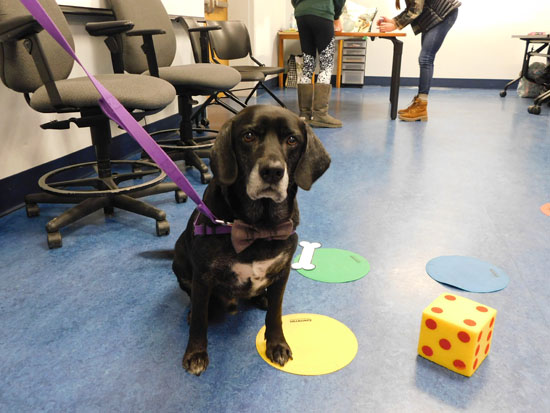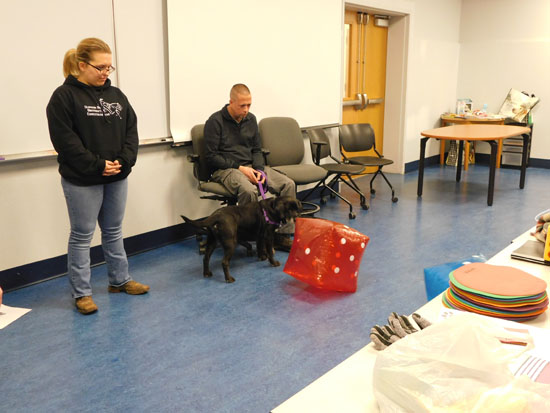Web ExclusiveCreativity and Canines in the Classroom
Chevy (therapy dog) playing a game for individuals dealing with physical challenges developed by Leah Deitt and Kristina Barcic. Photo courtesy of Yvonne Eaton-Stull Dogs never fail to bring a smile to most people’s faces. They capture our attention and foster compassion. Social work practitioners must utilize multiple methodologies to assist those they serve, being flexible and creative in how they address client issues and facilitate positive coping. Animal-assisted intervention (AAI) is a rapidly expanding specialty. AAI involves the incorporation of animals in health, education, and human service settings to benefit health and wellness (Pet Partners, n.d.). According to Tedeschi, Fitchett, and Molidor (2005), the documented evidence of the benefits that animals have on humans compel social work practitioners to consider this approach. Increasing numbers of social workers are bringing therapy animals into their practices. According to a national study conducted by Risley-Curtiss (2010), almost 25% of social workers are using animals in their work, yet most lack any specialized training in this area. Slippery Rock University (SRU) in Pennsylvania offers an opportunity for students to take an AAI elective in social work. This course provides students with foundational knowledge of the human-animal bond and offers strategies for integrating therapy animals into their future professions. “The human-animal bond is a mutually beneficial and dynamic relationship between people and animals that is influenced by behaviors that are essential to health and well-being” (American Veterinary Medical Association, 2018). SRU also has more than 75 students attempting to earn a minor in AAI along with their major, where they take 18 credits in social work and recreational therapy (including an equine assisted course) to prepare them for implementing such innovations to enhance the care and services provided to clients. Therapy dogs are specially trained and evaluated for calm, affiliative personalities and obedient temperaments. Alliance of Therapy Dogs (www.therapydogs.com) and Pet Partners (www.petpartners.org) teams (therapy dog handler and therapy dog) volunteer their time to assist in these classes. Therapy dogs are utilized to demonstrate goal-oriented interventions for students. Since many students will be working in a human service profession and will likely encounter crisis situations, another type of canine team is also utilized. Animal-assisted crisis response (AACR) teams include dogs that have been a therapy dog for at least a year and have received extensive evaluation and training to respond to chaotic situations, such as disasters. HOPE AACR (www.hopeaacr.org) teams also volunteer their time demonstrating the work of these specialized teams during crises. These HOPE AACR teams have responded to a variety of national crises and disasters, including Hurricane Harvey and various school shootings. A precursor to utilizing animals in the classroom involves receiving preapproval through the institutional animal care and use committee. Similar in process to an institutional review board, this university committee assures the welfare of animals in teaching and research as required by federal regulations. A professor hoping to utilize animals in the classroom must first complete training on the ethical use of animals. A detailed protocol with supporting documentation, such as the dog’s vaccinations and certifications, must be written and submitted for review. The committee then approves, denies, or requires revisions. A professor must have full approval prior to bringing any animals into the classroom. These protocol documents are submitted annually for each class.
Mike Stull (handler) and Chevy (therapy dog) playing Rolling the Pawsabilities (an activity game for individuals adjusting to amputations) developed by Emily Jones, Monica Loeffelman, and Kristen Glenn. Photo courtesy of Yvonne Eaton-Stull In an effort to develop their creativity and facilitate AAI, for their final project, SRU students had to develop a game, activity, or book integrating therapy dogs. Students selected a problem area that may be faced by clients they hope to work with in the future, such as grief or PTSD. Detailed instructions outlining the purpose and goals of the activity along with how the therapy animal is integrated was a requirement for this project. Some projects used the therapy animal in a passive manner for comfort and support while the client addresses something that may be difficult to discuss. Other projects involved the dog more directly, making him a part of the activity. Students embraced this assignment like no other, offering inventive ideas and developing engaging activities. Creative titles were formed, such as “Patches Matches” (a matching game developed by Megan Wiernusz for individuals with cognitive effects from epilepsy) and “Family Change Can Be Ruff” (developed by Natalie DeAngelis and Haylee Zinn for children facing family transitions). Students clearly spent a lot of time and effort in constructing these projects, using dog game pieces and animal-themed cards and pictures. Finally, students presented their project to the class, demonstrating with the therapy dog how their activity worked and what problem area it targeted. Volunteer students from the audience also participated as “clients,” which fostered active attention and involvement. Student feedback was consistently positive, with comments such as, “It was great to create something we could use in our future,” “We learned so much and had fun in the process,” and “definitely a better assignment than just having to write another paper.” Having therapy dogs in the class was the highlight for many students, but it also created a way to demonstrate how to use these animals to benefit others. Teaching future animal-assisted practitioners about the use of therapy animals to address a wide array of client needs is a rewarding experience. What is even more enjoyable is seeing the smiles on the student’s faces as they truly enjoy their educational experience. — Yvonne Eaton-Stull, DSW, MSW, is an assistant professor of social work at Slippery Rock University in Pennsylvania. She has two therapy dogs and actively provides animal-assisted therapy in various mental health facilities. She has also provided animal-assisted crisis intervention following crises and disasters throughout the United States, such as the Virginia Tech shooting, Indiana tornados, and Washington D.C. Navy Yard shootings. Her recent research has included four studies implementing animal-assisted interventions in state prisons.
References Pet Partners. (n.d.). Terminology. Retrieved from https://petpartners.org/learn/terminology/. Risley-Curtiss, C. (2010). Social work practitioners and the human-companion animal bond: A national study. Social Work, 55(1), 38-46. Tedeschi, P., Fitchett, J., & Molidor, C. E. (2005). The incorporation of animal-assisted intervention in social work education. Journal of Family Social Work, 9(4), 59-77. |



